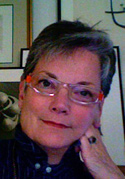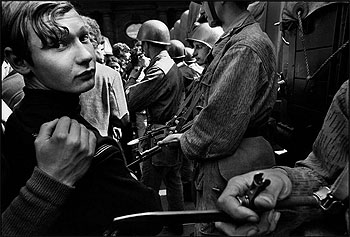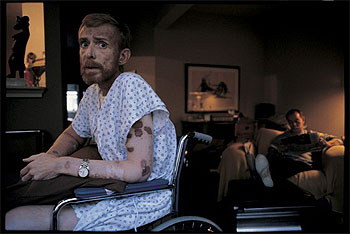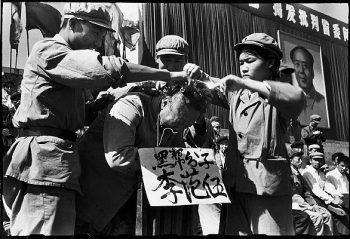 |
→ February 2007 Contents → Feature
|
Contact Press Images:
30 Years of Excellence February 2007
|
 |
||||||||||||
|
Contact Press Images celebrated 30 years of remarkable photography in 2006. Founded by Robert Pledge and David Burnett in 1976, the agency has maintained its involvement with humanitarian and human-rights issues. This involves the responsibility to understand an issue and see that it could have consequences beyond the borders of one's own town, region or country. Doing long-term stories on regime change, civil wars and genocide when they first appear on the horizon often means that a Contact photographer is aware and knowledgeable when the event evolves into a world news event. The vivid images of apartheid in South Africa, the civil war in El Salvador, the fall of the Shah of Iran, and 9/11 are visual markers of the 20th–21st centuries. Contact is one of the agencies that changed the landscape of photojournalism in Europe and America during the 1970s–1980s.
Magazines that stayed afloat increasingly did away with their expensive stable of photographers and bought photographs from older and newly formed agencies. Among the predominant agencies at the time were Black Star, Gamma, Magnum, Sipa and Sygma.
In 1973 Robert Pledge came to New York City to restart and energize the North American office for the French agency Gamma-Presse Images. He explained in a 1987 interview that "the agencies in effect became a substitute for their [the magazines'] photographers…. The agencies were coming up with the ideas, initiating the coverage, sending people out there…. Being highly competitive, they wouldn't even wait until an assignment or a financial commitment was made by anybody—just the first one who got there was the first one who had a chance [at sales]." (Fulton, "Eyes of Time")
Robert Pledge and David Burnett developed the concept of Contact Press Images (the name suggested by Jocelyne Benzakin was a salute to Gamma's early years and the work of Gilles Caron. Five people, including Raymond Depardon, founded Gamma in January 1967. Gilles Caron was the Gamma photographer whose work made Gamma's image). In February 1976 – 10 months after the collapse of Saigon and the hurried exit of Americans from Vietnam – Contact was founded. Pledge and Burnett invited Eddie Adams to join them as a founder but he played a small role in the agency and left in 1982.
Born in London, Robert Pledge moved to Paris at age 10 with his family. A student of West African languages and anthropology, he found his way into journalism as a specialist in African affairs writing for Jeune Afrique and Le Monde Diplomatique. Cornell Capa, founder of the International Center of Photography and member of Magnum, has described Pledge as "…this bespeckled [sic], bilingual, mumbling package of energy…." (Camera International, Spring 1987). In 1970, he became an editor of the French visual arts magazine Zoom. Three years later he joined Gamma.
Early in his career Contact's co-founder, David Burnett, became the last photojournalist to cover the American war in Vietnam under contract for Life magazine. In his 30 years with Contact, he has worked in over 70 countries and documented many world-changing events—the revolution in Iran (1979) and the fall of the Berlin Wall (1989), to name two. He also covered the coup in Chile (1973), the famine in Ethiopia (1984) and the U.S. military intervention in Haiti (1994). Since 1984 his work at the summer Olympics has been widely respected.
At Contact's 10th anniversary, Cornell Capa praised the agency for the quality of their work and "for upholding and creating new standards for our collective visual history." Capa understood from the first that Contact Press Images had all the characteristics of the original Magnum, founded after WWII by his brother Robert Capa (American, from Hungary), Henri Cartier-Bresson (French), George Rodger (British), David "Chim" Seymour (American) and William Vandivert (American).
The Contact group is also deliberately small, multinational and today almost one-third of its photographers are women. In 1976 and thereafter other photographers joined quickly. Alon Reininger (Israeli) became the fourth founding member. Then, Douglas Kirkland (Canadian-American), Rick Smolan (American), Gianfranco Gorgoni (Italian), Dilip Mehta (Indian) and Annie Liebovitz (American) joined in the first few years of the agency's existence. In 1982 Jose Azel (Cuban-born American) and Frank Fournier (French) became part of Contact.
Contact brings together two traditions in photojournalism: the French and American. Robert Pledge describes the stylistic differences in the early years: "At least until recently, the approach of the French photojournalists at the agencies was more broad, more raw. They were not people who were overtly concerned with graphics and composition and quality – light and color, etc. They were much more concerned with getting the images and making a point. [In America] there are newspaper traditions, the Life tradition and the National Geographic tradition. None of these traditions really existed in France, at least not in the same way as they do here." Contact inherited the French emphasis on the "auteur" (the photographer's personal vision) that was seen to be the equal to that of the word journalist and combined this with the structure of the photo essay as seen in Life.
Today the photographers of Contact remain true to the values that prompted them to found and join the agency in the first place. They still feel the responsibility to highlight those issues that affect humanity at large. The enemy is not the competition of another agency, Pledge said recently, but time. It's not that technology has sped up shooting and publishing time—it's a useful tool—but that speed has become an end in itself. He feels that each photographer must, in effect, learn to speak slowly and in an articulate way. Know what you're covering and why. Be careful to understand the dynamics of a society and resist snap judgments.
While the focus on people remains the same, the world today is more complex than it was 30 years ago. Battles and diseases have been globalized—decisions made too quickly affect not only the immediate people involved but have repercussions throughout a region and, potentially, the world.
Whatever the challenges ahead, Contact Press Images hopes to continue rising to the occasion and keep on telling the long-term story.
[Please see contactpressimages.com to view more images.]
© Marianne Fulton
|
|||||||||||||
Back to February 2007 Contents
|
|



